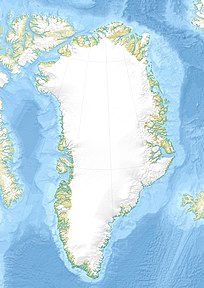Siorapaluk
| Siorapaluk (small sand) | ||
|---|---|---|
| Siorapaluk | ||
| Siorapaluk with the beach | ||
| Commune | Avannaata Communia | |
| District | Qaanaaq | |
| Geographical location | 77 ° 47 '10 " N , 70 ° 38' 13" W | |
|
|
||
| Residents | 43 (January 1, 2020) |
|
| Time zone | UTC-3 | |
Siorapaluk [ siɔˈʁapaluk ] ( Inuktun Hiorapaluk [ hiɔˈʁapaɾu (k) ]) is a Greenlandic settlement in the district of Qaanaaq in the Avannaata communia .
Siorapaluk is considered the northernmost natural settlement in the world today .
location
Siorapaluk is the northernmost settlement of Greenland and is 1358 km to the North Pole a little further south than Longyearbyen on Spitsbergen (1309 km). The place is located on the south coast of a glaciated peninsula on the north bank of the Siorapaluup Kangerlua (Robertson Fjord). The closest place is the district capital Qaanaaq , which is 49 km southeast.
history
Siorapaluk is mainly inhabited by the descendants of the Canadian Inuit who came to northern Greenland via Smithsund around 1880 . The place is part of the Avannarliit residential group , the northernmost of the Inughuit . Siorapaluk received Udsted status in 1939 and a packing house was built. In 1946 the place received a school band. In 1951 Siorapaluk had 41 residents. Within a short period of time, the population rose sharply. In 1952 43 people lived in Siorapaluk, in 1953 59 and 1954 there were 67 inhabitants. In 1960, 82 people lived in Siorapaluk. In 1970 there were only 72.
economy
The inhabitants of Siorapaluk live mainly from hunting crab grebes , thick-billed mummies , arctic foxes , arctic hares , seals , walruses and polar bears . Further employment opportunities are offered by handicrafts, schools, shops, administration and tourism, which is mainly based on dog sledding tours and the presentation of the Inuit culture with drum dancing , choir singing and kayaking .
Infrastructure and supply
Siorapaluk has no port and the boats are on the beach. The sea is ice-free and navigable from July to September. Once a year the place is approached by a supply ship. Air Greenland provides year-round helicopter flights via the Siorapaluk heliport . The rest of the transport to Qaanaaq is done by dog sledding or snowmobiles .
Nukissiorfiit ensures the power supply via a power plant, but there is no regulated drinking water supply. The residents get water from the river that divides the place or from snowmelt in winter. Garbage is dumped and incinerated, while sewage is drained into the ground. TELE Greenland guarantees the telecommunication connection of the residents.
Development
The school in Siorapaluk, Evap Atuarfia , has taught around seven students up to the seventh grade since its establishment in 2006 and also houses the chapel and a small library. A Pilersuisoq branch is responsible for supplying the population with goods. There is also a village office, an infirmary and a service building, as well as an assembly building in Siorapaluk.
Sons and daughters
- K'issúnguaĸ Kristiansen (* 1930), Provincial Councilor
Population development
The population of Siorapaluk increased by about half between 1977 and 2006 and has since halved.

Web links
- Michael Martin : Northern Greenland in winter: dog cold in eternal ice. Spiegel Online . March 7, 2012.
- Ines Kaffka: Siorapaluk in Greenland Minus 30 degrees, no shower - and you hunt the food yourself. Spiegel Online. January 24, 2019.
Individual evidence
- ↑ Map with all official place names confirmed by Oqaasileriffik , provided by Asiaq
- ↑ a b c d Siorapaluk at qaasuitsup-kp.cowi.webhouse.dk
- ↑ Jens Christian Madsen: Udsteder og bopladser i Grønland 1901-2000 . Atuagkat, 2009, ISBN 978-87-90133-76-4 , pp. 204 ff .
- ↑ Population of Siorapaluk 1977–2020 at bank.stat.gl


